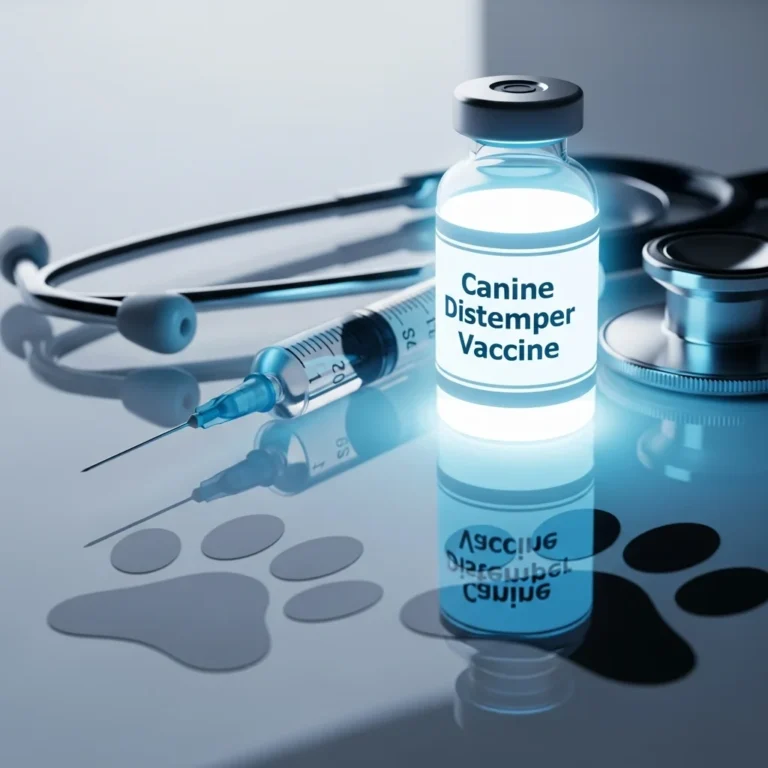
distemper vaccine
Dogs, much like human infants, rely on timely immunological defenses to keep lethal pathogens at bay. Among these, canine distemper virus (CDV) stands out as a formidable adversary—an insidious viral invader that can ravage multiple organ systems and leave survivors with permanent neurological damage. The distemper vaccine is a crucial bulwark in your pet’s health arsenal, offering protection, peace of mind, and a shield against a disease that was once ubiquitous. In this deep dive, we journey from fundamental principles through nuanced caveats, weaving in expert authority and real-world guidelines to help you navigate the labyrinth of canine vaccination.
💉 1. Basics: What the Distemper Vaccine Does
What is the distemper vaccine, and which disease does it protect dogs from?
The distemper vaccine for dogs is a biologic immunogen designed to instigate an immune response against canine distemper virus (CDV), a highly contagious paramyxovirus. It trains a dog’s immune system to recognize viral antigens—especially the fusion (F) and hemagglutinin (H) proteins—before real exposure. source
Without vaccination, distemper infection can manifest as fever, respiratory distress, intestinal symptoms, and neurological signs such as seizures or paralysis. source
Why is the distemper vaccine considered a “core” vaccine for dogs?
Veterinary bodies universally designate it as a “core” vaccine because the risk of disease spread and severity is high, and the benefits of immunization far outweigh the risks. The American Veterinary Medical Association (AVMA) emphasizes that canine distemper is invariably prevented by a robust vaccine program. source
Renowned vaccine researcher Ronald Schultz, PhD, demonstrated in controlled challenge studies that puppies vaccinated just hours before CDV exposure still achieved full protection. source
Can other animals, like ferrets, get distemper — and do they require a different vaccine?
Yes. Ferrets are susceptible to morbilliviruses analogous to canine distemper, and in fact many canine distemper vaccine used in ferrets are tailored or labeled specifically for mustelids. Dogs and ferrets generally should not share the same vaccine formulation. In wildlife, species such as raccoons, foxes, and skunks also can be infected, making wild reservoirs a concern. source
🩺 2. Safety, Risks & Readiness (Top priority for readers)
What are the common short-term side effects after a distemper vaccination, and when should I be concerned?
Mild adverse events are quite common and typically self-limiting: lethargy, slight fever, local swelling or soreness at the injection site, a mild cough, or decreased appetite. According to a study cited by Morris Animal Foundation, roughly 19.4 adverse reactions per 10,000 vaccinations were reported, mostly within three days. source
You should be concerned if any of these persist beyond 48 hours, worsen instead of improving, or are accompanied by vomiting, diarrhea, facial swelling, or collapse.
What are the signs of a severe allergic or anaphylactic reaction, and what should I do if they occur?
Signs of a serious systemic reaction may include:
- Facial or muzzle swelling
- Hives or urticaria
- Difficulty breathing, wheezing, or soft cough
- Collapse or sudden weakness
- Vomiting or diarrhea
- Pale gums, rapid heart rate, or hypotension
If you see any of these, seek emergency veterinary care immediately. Administering antihistamines alone is insufficient; professional intervention (e.g. epinephrine, IV fluids, supportive care) is essential.
Is the distemper vaccine safe for pregnant or nursing dogs?
Use in pregnancy is a nuanced question. Modified live vaccines (MLVs) are typically avoided in pregnant or actively breeding females due to theoretical risks of viral replication causing fetal harm. Many veterinarians prefer either to vaccinate before breeding, or use more conservative recombinant or killed formulations if immunization is essential during that period. Consultation with a veterinary immunologist is strongly advised.
Can the distemper vaccine cause neurological or long-term health problems, and how rare are these events?
Reports exist, though they are exceedingly rare. One 2023 study documented post-vaccinal distemper-like lesions in litters, though these were extremely rare and confirmed by RT-PCR to be vaccine-derived strains. source
While speculative claims about vaccines causing autism or general immune disorders are common in pet-owner forums, there is no credible scientific evidence to support those claims in dogs. The overwhelming consensus among veterinary immunologists is that serious long-term sequelae are extraordinarily rare.
🐶 3. Puppy & Adult Vaccination Schedule
When should a puppy get its first distemper shot, and how many doses are needed in the series?
Puppies typically receive their first distemper vaccination at 6 to 8 weeks of age, then boosters every 3 to 4 weeks until they reach ~16 weeks old. source
This series is intended to “bridge the gap” as maternal antibodies wane—antibodies from mother’s milk can neutralize a vaccine if given too early. source
How often do adult dogs need booster shots — yearly, every 3 years, or otherwise?
Traditionally, many practices used annual boosters, but current science supports triennial (every 3 years) boosters for healthy adult dogs if using appropriately labeled vaccines. A challenge study by Gore et al. demonstrated that a multivalent MLV vaccine prevented distemper for at least 3 years following a two-dose protocol. source
A German study found that 94.8% of adult dogs already had detectable antibodies pre-vaccination, and no dog showed a ≥4-fold boost, suggesting many already maintained immunity. source
What is the best vaccination plan for rescue dogs or those with no known history?
Rescue or unknown-history dogs should typically be treated as unvaccinated: start a full puppy series or at least two distemper vaccine doses separated by 3 to 4 weeks, then recheck in one year and shift to a longer booster interval based on their health and titer results.
What should I do if my dog missed part of the vaccine series or skipped a booster?
Do not assume your dog is protected. Return to a veterinarian and restart the vaccine series or give a booster as soon as possible. If more than a year has lapsed, redoing the series or performing a titer test is often prudent.
⚗️ 4. Vaccine Types & Formulations
What types of distemper vaccines exist (modified live, recombinant, or killed), and how do they differ?
- Modified live virus (MLV): contains attenuated but replication-competent virus. Strong immunogenicity and duration, but theoretical risks in immunocompromised or pregnant animals.
- Recombinant (vector-based, e.g., canarypox) vaccines: the distemper antigens are expressed via a harmless viral vector; no live CDV replication in the dog. Some have been studied in challenge models. source
- Killed (inactivated): safer in delicate patients but often less immunogenic; might require adjuvants and more frequent boosters.
Which vaccine type is recommended for puppies, elderly, pregnant, or immunocompromised dogs?
For standard healthy puppies, MLV or recombinant vaccines are excellent choices.
For elderly, immunocompromised, or pregnant dogs, veterinarians often lean toward recombinant or killed vaccines to minimize theoretical replication risks.
Are multivalent vaccines like DA2PP or DHPP the same as a distemper vaccine?
Yes and no: those multivalent formulas include the distemper (D) component along with vaccines for adenovirus (A), parvovirus (P), and sometimes parainfluenza (P). They are not a standalone distemper vaccine but often are how distemper immunization is delivered in practice.
🧬 5. Immunity, Effectiveness & Titers
How effective is the distemper vaccine — does it provide full protection?
It is highly effective. Ronald Schultz’s challenge data demonstrated full protection even with last-minute vaccination. source
However, no vaccine is perfect. Breakthrough infections can occur, but vaccinated dogs are far more likely to have milder or atypical signs. source
How long does immunity last, and can antibody titer testing replace regular boosters?
Immunity often persists for at least 3 years, sometimes longer. The study by Gore et al. demonstrated 100% clinical protection up to 3 years post vaccination. source
Indeed, titer testing (measuring neutralizing antibody levels) is increasingly embraced as a tool to tailor booster decisions. The German study showed high baseline titers in adult dogs. source
Veterinary guidelines now increasingly support using titer results to determine whether a booster is necessary — though not all veterinarians adopt this. source
What factors can reduce vaccine effectiveness, such as maternal antibodies or poor health?
- Maternal antibodies can neutralize vaccine antigen if given too early.
- Concurrent illness, stress, or immunosuppression can blunt the immune response.
- Poor vaccine storage or handling (cold chain failure) can degrade potency.
- Genetic nonresponders (rare) who fail to mount an adequate immune response.
- Viral drift or new strains (though CDV is relatively antigenically stable).
🧓 6. Special Populations & Situations
Should dogs with chronic illness, on steroids, or with weak immune systems be vaccinated differently?
Yes — these dogs pose a higher risk of adverse reaction or suboptimal response. A tailored protocol may include using recombinant or killed vaccines, delaying nonessential vaccines, spacing them out, or performing antibody titer checks more frequently. Collaboration with a veterinary immunologist is wise.
Can vaccinated dogs still contract distemper, and if so, are their symptoms milder?
Yes, in rare cases “breakthrough” infection is possible, especially if the dog’s immunity wanes or the exposure dose is overwhelming. But in such cases, symptoms tend to be attenuated — fewer neurological complications, milder respiratory signs, and better survival odds.
💰 7. Practical & Legal Considerations
Is the distemper vaccine legally required for boarding, grooming, or daycare facilities?
Many boarding, grooming, and daycare facilities do require proof of current core vaccinations (which usually include distemper). Though not always mandated by law, the requirement stems from facility policy to protect all animals in close contact.
How much does the distemper vaccine usually cost, and where can I find low-cost vaccination clinics?
Costs vary by region, clinic, and whether it’s part of a multi-vaccine package. In many places, a distemper vaccine alone might cost anywhere from $20 to $60 USD or equivalent in local currency. Low-cost clinics, shelter programs, or veterinary schools often provide discounted vaccine services; checking with local animal welfare organizations is wise.
Can the distemper vaccine be given alongside other vaccines, and where on the body is it usually injected?
Yes — it is often administered in a multivalent vaccine (e.g. DA2PP) concurrently with other core vaccines like parvovirus. The injection is typically given subcutaneously (under the skin), often in the scruff (loose skin between shoulder blades) or in a distal limb (so reactions are more easily isolated).
🧫 8. Diagnosis & Outbreak Response
How is canine distemper diagnosed, and can vaccination affect test results?
Diagnosis may include PCR, virus neutralization antibody testing, immunofluorescence, or clinical signs in combination with laboratory assays. source
Vaccination may confound serology tests because of induced antibody presence; thus, interpretation must consider vaccination history. Some assays (e.g. quantitative neutralization titer) distinguish between vaccine-derived and wild-type response.
What should I do to protect my dog during a local distemper outbreak — should I isolate or revaccinate?
- Isolation: Avoid dog parks, boarding, or places with high dog traffic until the outbreak subsides.
- Revaccination (booster): If your dog’s booster is pending or lapsed, a booster may help (especially within a short time window).
- Quarantine new dogs: Before introducing new dogs, isolate them for several weeks and confirm vaccination histories.
- Monitor symptoms: Be vigilant for cough, fever, discharge, neurological signs.
- Consult your veterinarian about prophylactic strategies — some may even recommend immediate titer testing or emergency boosters for high-risk dogs.
🚫 9. Myths & Misinformation
What are the most common myths about the distemper vaccine (e.g., vaccines cause autism, weaken the immune system)?
- “Vaccines cause autism in dogs” — There is no scientific basis for this claim in any species.
- “Vaccines overwhelm or weaken the immune system” — In reality, vaccines train and bolster defense, not degrade it.
- “One vaccine can cover lifetime immunity” — Evidence shows immunity declines in many animals; periodic boosters or titer checks are needed.
- “Less is always safer” — Skipping core vaccines exposes your pet to real, lethal risk.
Can home remedies or “natural vaccines” replace the distemper vaccine safely?
Absolutely not. Claims of herbal concoctions, homeopathic remedies, or “natural immunization” lack credible scientific evidence. The distemper vaccine is derived from rigorous virology and immunology research; no natural alternative matches its proven efficacy. Choosing to skip or replace it is inviting disease risk.
Vaccination against CDV is a cornerstone of responsible dog ownership. Through understanding its benefits, limitations, schedules, and risks — and by consulting veterinary experts — you can craft a vaccination strategy that maximizes protection while honoring your pet’s individual needs.
please leave comment
you may like it






